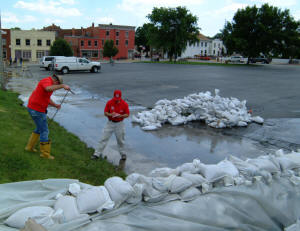 The U.S. Army Corps of Engineers has created a more comprehensive and rigorous levee inspection process under its Levee Safety Program to aid District offices in communicating to local levee sponsors and the public the overall condition of the levee system and recommending actions to reduce flood risk.
The U.S. Army Corps of Engineers has created a more comprehensive and rigorous levee inspection process under its Levee Safety Program to aid District offices in communicating to local levee sponsors and the public the overall condition of the levee system and recommending actions to reduce flood risk.
Why is it important to continuously conduct levee inspections?
- Ensure the levee system will perform as expected.
- Identify deficiencies or areas that need monitoring or immediate repair.
- Continuously assess the integrity of the levee system to identify any changes over time.
- Collect information to help make informed decisions about future actions.
- Provide the public with reliable information about levees.
The Corps conducts two types of levee inspections as part of the Levee Safety Program:
- Routine Inspections, also called annual inspections or continuing eligibility inspections, are visual inspections that verify proper levee system operation and maintenance. Routine Inspections are conducted on an annual basis.
- Periodic Inspections provide a more rigorous assessment than the Routine Inspection and include a more detailed and consistent evaluation of the condition of the levee system. Periodic Inspections verify proper operation and maintenance; evaluate operational adequacy, structural stability and safety of the system; and compare current design and construction criteria with those in place when the levee was built. Periodic Inspections are conducted every five years.
Both Routine and Periodic Inspections incorporate a consistent inspection checklist and result in a levee system rating for operation and maintenance. This rating determines if a levee system is active in the Corps’ Rehabilitation and Inspection Program. Active levees are eligible for federal rehabilitation funds for flood damages. A levee system must maintain an acceptable rating to remain active. If a project receives a minimally acceptable or unacceptable Inspection rating, it may become ineligible for federal rehabilitation assistance if damaged in a flood or storm event.
“Levee safety and communicating risk is a shared responsibility among federal, state, local and private partners and is important for individuals to make public safety decisions,” said Alan Tamm, the District’s Levee Safety Program manager. “Periodic Inspections offer a more comprehensive look into levee systems and provide additional data to help make risk-informed decisions about flood risk management.”
Inspection results of acceptable, minimally acceptable or unacceptable are provided to project sponsors to address deficiencies. Additionally, the District will work with sponsors to identify performance concerns, areas for further analysis, changes in design criteria and potential consequences of levee failures that need to be addressed in order to provide the continued safety of the levee.
The American Recovery and Reinvestment Act (ARRA) of 2009, also referred to as the Economic Stimulus Bill, passed by the U.S. House and Senate and signed by President Barack Obama on February 17, 2009, provided $90 million for the Corps of Engineers to conduct Periodic Inspections of levees covered by the Levee Safety Program.
Private-sector contractors will accelerate Periodic Inspections of federal levees. Federal levees include projects operated and maintained by the Corps and projects designed and built by the Corps then turned over to local sponsors. Contractors, in cooperation with levee districts and local project sponsors, will inspect and evaluate the levees as part of USACE ongoing Levee Safety Program to ensure local sponsors are performing their operations and maintenance responsibilities and to determine eligibility for the Corps Rehabilitation and Inspection Program made available under Public Law 84-99. Corps Rehabilitation and Inspection Program includes federal rehabilitation assistance if damaged by a flood event. Projects must have an acceptable maintenance inspection rating to remain eligible for federal rehabilitation assistance.
Sponsors of projects rated minimally acceptable or unacceptable may request temporary extensions of eligibility for the Rehabilitation and Inspection Program if taking system-wide steps to reduce flood risks.
The development of a National Levee Safety Program is a combined effort of many individuals with divergent ideas. Two important principles guiding the Levee Safety Program are the shared responsibility among partners at all levels for levee safety and the need for communication of risk as discovered in the continuous and periodic levee system inspections and assessments. Partners include the Corps, levee and drainage district sponsors, other federal and state agencies as well a citizens that make their own risk-based choices.